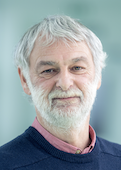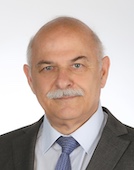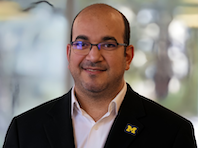IEEE International Conference on Emerging Technologies and Computing
ICETC2025
June 23-26, 2025, Brest-France
|
|
|
Invited TalksGeometric and end-to-end robot vision-based control François CHAUMETTE, Inria Senior Research Scientist, France Abstract: As for humans and most animals, vision is a crucial sense for a robot to interact within its environment. Vision-based robot motion control, also named visual servoing, is a general approach to close the perception-action loop. The aim of this talk is to provide a comprehensive state of the art on the basic concepts, methodologies, and applications. In a first part, the traditional approach based on geometric visual features, such as image points, image moments, or camera-object pose will be described. The more recent end-to-end approach that directly uses the image content without any image tracking nor matching process will be also considered, providing a link to CNN modern methods that use the same inputs. Controling the shape of deformable objects will be also considered. Keywords: robotics, computer vision, visual servoing
Renewable Energy Systems: Current Status in the World and Prospects Soteris A. KALOGIROU, Professor, Cyprus University of Technology, Cyprus Abstract: This presentation examines the current status of renewables in the world. The presentation starts with some facts about climate change, global warming, and the effects of human activities, such as the burning of fossil fuels on the climate problem. It then outlines of the status of renewables in the world, which includes their shares with respect to conventional fuel use for power and for electricity production alone, and their social dimension in terms of jobs created. Then the basic forms of renewables are examined in some detail, which include solar thermal, both for low and high temperature applications, photovoltaics, hydro power, onshore and offshore wind energy systems and biomass/biofuels. In all these the basic technology is presented followed by the current status, the installed capacity in the last decade, which reveals their upward trend, as well as the prospects of the technology and some new research findings. Keywords: Renewable energy, solar thermal, photovoltaics, wind energy, hydro power, biomas
Quantum communication, fundamentals, and technology trends Kamel BESBES, Professor, IEEE Senior member, Centre for Research on Microelectronics & Nanotechnology, Sousse Technopole, Tunisia Abstract: Quantum communication represents a paradigm shift in information transfer, leveraging the unique principles of quantum mechanics to achieve unprecedented levels of security, speed and efficiency. Quantum networks are ready to revolutionize future communication technologies, offering new investigation field. This talk will provide an overview of recent breakthroughs in quantum communication, highlighting key concepts like quantum key distribution and teleportation, and exploring the emerging trends in quantum network development. We will discuss the current state of this rapidly advancing field and its potential to reshape global communication infrastructure, such as satellite-based quantum communication and quantum assisted architecture. Keywords: Quantum fundamentals, Quantum assisted architecture, Quantum communication, Quantum application trends
Software Refactoring: Challenges and Opportunities in the Era of Artificial Intelligence Mohamed Wiem Mkaouer, Associate Professor, College of Innovation & Technology, University of Michigan-Flint, USA Abstract: Refactoring is a critical task in software maintenance and is usually performed to enforce better design and coding practices while coping with design defects. The Extract Method refactoring is widely used to merge duplicate code fragments into a new method. Several studies attempted to recommend Extract Method refactoring opportunities using different techniques, including program slicing, program dependency graph analysis, change history analysis, structural similarity, and feature extraction. However, irrespective of the method, most existing approaches interfere with the developer’s workflow: they require the developer to stop coding, analyze the suggested opportunities, and consider all refactoring suggestions in the entire project without focusing on the development context. To increase the adoption of the Extract Method refactoring, in this tutorial, we aim to show the effectiveness of machine learning and deep learning algorithms for its recommendation while maintaining the developer's workflow. Finally, we demonstrate a case study on how LLMs can be useful to recommend the Extract Method refactoring. Keywords: Software Engineering, Extract Method refactoring, Artificial Intelligence, Machine Learning, Deep Learning
Chip-Wise DSSS-FTN Signaling with time-varying random sequences - A promising solution for covert communications Pascal Chevalier, Professor, Conservatoire National des Arts et Métiers, Paris, France Abstract: Wireless communications with low probability of detection, also called covert wireless communications, arouse growing interest for both military and civilian applications. The main existing solution used in practice to hide a wireless transmission is the well-known direct sequence spread spectrum (DSSS) technology, which suffers from two main limitations: a spectral efficiency loss and a second order (SO) cyclic vulnerability, since a DSSS signal always exhibits SO cyclostationarity, which may be detected by well-suited SO cyclic detectors. A promising solution, introduced very recently, to overcome these two main limitations of a DSSS signal, while keeping all its benefits, is the chip-wise DSSS-Faster-Than-Nyquist (DSSS-FTN) signaling. The first purpose of this presentation is to present the main characteristics of a DSSS-FTN waveform in terms of Spectral Efficiency, PAPR, power and SO cyclic covertness for arbitrary truncated pulse shaping filters, squeezing and spreading factors, for amplitude shift keying (ASK), phase shift keying (PSK) and quadrature amplitude modulations (QAM) symbols, assuming time-varying random spreading codes. The second purpose of the presentation is to give conditions on the spreading factor, for arbitrary values of the squeezing factor, allowing to use a simple matched filter receiver with minimal complexity, while reaching the Nyquist Matched filter bound (MFB) performance. Finally, the chip-wise DSSS-FTN signaling is compared to the classical DSSS-Nyquist signaling through a multi-criteria approach, showing the great interest of the former for efficient covert communications. Keywords: FTN, DSSS-FTN, PAPR, Multi-criteria, MLSE, Penalized SNR, Time-varying code, ASK, PSK, QAM symbols, Power covertness, SO cyclic covertness, Spectral efficiency
|






